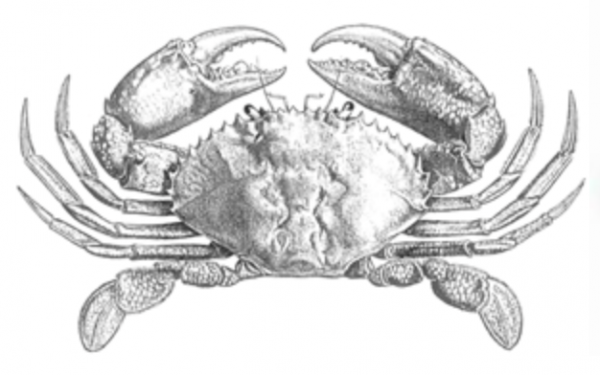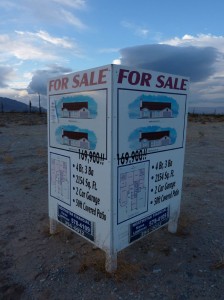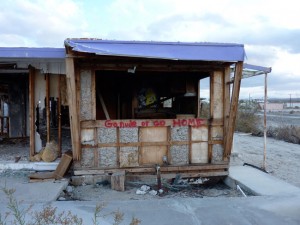 This project will update and extend the Lagoon Cycle (1972 – 1984), created by the western art field’s eco-art pioneers, Helen and Newton Harrison. The thirty-panel work is housed in the Pompidou Art Centre collection and is about watershed ecosystems, life’s complexity, human hubris and climate change. It entails an exchange between a lagoon-maker searching for technological solutions to enable a specific of crab from Sri Lanka to live under museum conditions and a witness critically assessing them, in areas of California including Los Angeles and the Salton Sea. As the story progresses, the Harrisons widen the scope of their environmental concerns until they conclude with a consideration of the ecosystem of the entire Pacific Ocean and a discourse on the greenhouse effect.
This project will update and extend the Lagoon Cycle (1972 – 1984), created by the western art field’s eco-art pioneers, Helen and Newton Harrison. The thirty-panel work is housed in the Pompidou Art Centre collection and is about watershed ecosystems, life’s complexity, human hubris and climate change. It entails an exchange between a lagoon-maker searching for technological solutions to enable a specific of crab from Sri Lanka to live under museum conditions and a witness critically assessing them, in areas of California including Los Angeles and the Salton Sea. As the story progresses, the Harrisons widen the scope of their environmental concerns until they conclude with a consideration of the ecosystem of the entire Pacific Ocean and a discourse on the greenhouse effect.
Through the work’s key idea of the importance of paying attention to beliefs and the enacting of desire, viewers of the work will be led through the different perspectives of the lagoon maker (science) and the witness (wisdom) alongside other story characters representing ideal types of Sri Lankan society and culture, and the working of our Western market economy. In this way, the installation viewers will occupy the space/psychology of the characters/archetypes so that they can challenge their own positions and complete the complex personal development cycle of the work.
At one level, the realisation of this new artwork reverses the standard approach of a science-art collaboration by using a medical health program to engage creative participation for production of the new work, Lagoon reCycle, and to illustrate aspects of the original artwork. A kidney can stand in for a lagoon and a body is an eco-system. Further to this, both the art and science led creativity in this program are means for assimilating the lived worlds of Sri Lankans and the Harrisons; instruments for knowing in the course of the journey towards what is called ‘absolute truth’. Scientific knowledge will make its way up an endless staircase successively replacing old with new for the sake of the important positivistic, pragmatic activities of improving community kidney health. Russian filmmaker Andrei Tarkovsky describes the way that artistic discovery nests hieroglyphs of ‘absolute truth’ each time new and unique images of the world are created. The Harrisons’ Lagoon Cycle does this, and new art elements in the work will also reach out to touch the human and eternal in our souls.
In the DFAT-funded health program, ANSTO is acting as a convenor in bringing together Australian and Sri Lanka researchers and community participants, to design and implement a public health program to tackle chronic kidney disease in Sri Lanka. The work includes the systematic study of drinking water sources, food, and the assessment of kidney of function, also called ‘glomerular filtration rate GFR’. There are presently no reference or baseline data of normal kidney filtration based on healthy populations in Sri Lanka. Hence, ‘normal values’ are borrowed from North-American men who were studied as early as the 1950s.
Importantly, the normal filtration capacity of the kidney crucially depends on healthy infant development. Presently, nearly every second Sri Lankan child is at some risk of food insecurity and in many children there are signs of stunted growth, which increases the risk for many diseases, including kidney failure, in adulthood. The problem of food security must include systemic nutritional security, i.e. the food must not only be providing calories, but have enough protein and be high in nutrients as well as being free of high levels pollutants. Rice is the country’s staple diet. There is now a challenging balance to be found between achieving sufficiently high yield and the risks of overfertilisation of the rice crops, that can cause high nitrogen content in ground water and has also in some cases known to increase the crop’s levels of arsenic and cadmium, both potentially toxic to the kidney.
The food related activity of the workshops will directly explore the Lagoon Cycle’s themes and questions around planning, technology and eco-systems; whilst playing with agriculture’s sculptural and natural forms. Questions to be refined and explored include:
How can we emerge from high density farming that has developed a dependency on fertiliser?
What is the traditional value of rare heritage / wild / whole rice with their higher quality proteins?
What crops can potentially mitigate ongoing climate change and carbon footprint concerns?
What can we learn from different waterway, water storage systems and mutual pond systems, such as those of the earliest Mesolithic Period and structures/technologies/practices from a range of Indigenous cultures?
How do we address issues of scale to develop and implement systems that support natural and carrying capacities, and food sovereignty? For example, two acres of land can feed an extended family.
How do we work with the natural wealth of Sri Lanka and garner broader support to address issues such as urbanisation and big farming that impact onground options to realise our goals?
OTHER PARTNERS
Sri Lanka-born Venerable Covina from Katoomba’s Buddhist temple is looking to assist in areas of translation and by working with monks in Anuradhapura.

 Creative interpretation will also explore changes over time, given 40 years have past since the Harrisons made this work. Preliminary investigation in California involved visiting the Harrisons and the Salton Sea. In the short video below Helen and Newton read a section of the Lagoon Cycle that describes the irreparable environmental degradation from compounding planning mistakes and short-term focussed commercial exploitation of the Salton Sea.
Creative interpretation will also explore changes over time, given 40 years have past since the Harrisons made this work. Preliminary investigation in California involved visiting the Harrisons and the Salton Sea. In the short video below Helen and Newton read a section of the Lagoon Cycle that describes the irreparable environmental degradation from compounding planning mistakes and short-term focussed commercial exploitation of the Salton Sea.